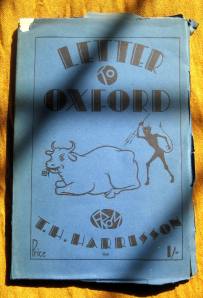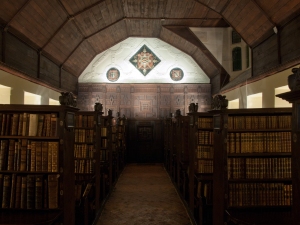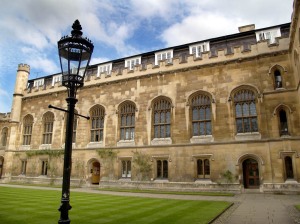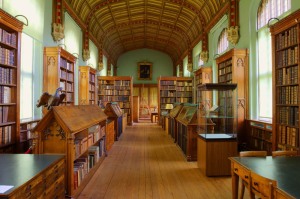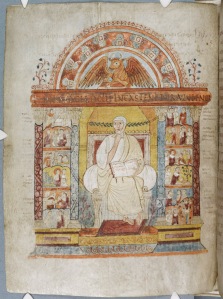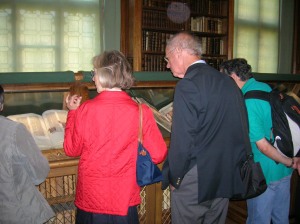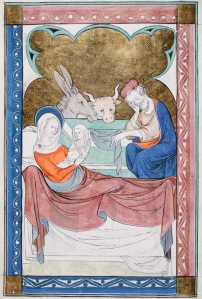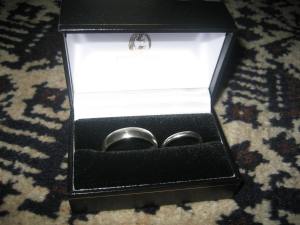This post finds me in a new post. I’m working in another library with good special collections but here we don’t have the benefit of any exhibition space to display them. So, I’m turning to the online exhibition. In search of good practice I explored the libraries listed on the Historic Libraries Forum’s new online map.
Here are a few of the examples I found and the thoughts and questions I came up with. I’m afraid this is a picture light post but if you follow the links you will find an abundance. Please do comment with any thoughts or examples you have too.
How are they mounted?
There are more different formats for an online exhibition than I first imagined. Choice of format has implications for presentation and accessibility.
My favourite online exhibitions used straightforward linked html webpages, such as this wizard exhibiton (quite literally) from the Roderic Bowen Library and Archives, or a blog such as the Christ’s at War blog exhibition blog from Christ’s College, Cambridge.
There were also some good examples of mounting a PDF to be download from a website. The University of Liverpool have used this technique in their highlights gallery. This can have the advantage of directly reusing a hard-copy exhibition catalogue as St John’s College, Oxford demonstrates with its current exhibition: Something rich and strange.
Other alternatives seems to impinge a bit on accessibility. I couldn’t make an exhibition using flash at the Royal College of Physicians of Edinburgh work for me, and having to download other software to view turning the pages at the Newcastle Collection put me off browsing. (I’ll talk more about the use of multi-media in a minute).
What about the content?
Just as the format varied enormously between exhibitions so did the actual content and its presentation. Clearly, some of this depends on the target audience.
The ratio of pictures/exhibits to explanatory text was one area of difference. Some libraries went with a selection of images to tantalize bookworms’ tastebuds, seasoned with a minimal amount of text. Manchester Public Libraries has some real gems in its special collections but left me wanting more and not sure how to get it, short of taking a trip to Manchester. Perhaps this is aimed at a more local audience who can visit.
The University of Liverpool special collections goes to the other extreme and mounts the exhibition text only leaving you to imagine the exhibits. ( Although see my comments about their PDFs of highlights above for some images from their collections). This might be good for the academically minded but pictures tend to be more immediately engaging.
My favourite exhibitions go for a mixture of text and pictures. As well as the Roderic Bowen Library and Archives exhibition pages above, these include The Crawford Collection at The Royal Observatory Edinburgh which simply has four pictures from the collection with text. The good thing is you can click through to a bigger version of the image. For teachers, the higher quality the image the better (for use on interactive whiteboards). The Royal College of Physicians of Edinburgh’s 150 years of membership exhibition does big images really well.
For a mix of images and text, I also liked Saffron Waldon Town Library’s online exhibitions. (Although I’d like to look at some of the images more closely).
I said I’d get onto use of multimedia. This is where online exhibitions come into their own: with the delivery of audio files, videos, podcasts…
Watch this video of a woodblock in use from the Bewick Collection in Newcastle Public Libraries. Or, of particular interest to fans of Time Team’s Phil Harding, the introduction to library collections from Wiltshire Heritage.
The Royal College of Physicians of Edinburgh offers recordings of lectures, some accompanied by slide shows, based on their collections, delivered by academics from a variety of institutions. And Chawton House offers podcasts of lectures held in and about the Library.
And the layout?
I saw some good ideas for layout (although I can’t knock a traditional linearly linked collection of exhibits):
The highlights tour at Leeds Brotherton Library (especially the ‘And more…’ section at the end of each article. Providing the next step whether it be a link or a reference to further reading is helpful).
Similarly, the timeline of highlights at St John’s College, Cambridge.
The seasonally apt advent calendar at the University of Liverpool.
The alternative overview/navigation by pictures in the Fred Hoyle Exhibition also at St John’s College, Cambridge.
And visitor interaction?
I didn’t find too much of this but perhaps I wasn’t looking hard enough or didn’t look at the right websites. I’m sure there must be more scope to allow the audiences of an online exhibition to participate in it more fully. Though I’m not sure how much more participation most visitors would want after reading the text, looking closely at the images, and watching or listening to the multimedia (particularly that involving Phil Harding).
The Bodleian’s new Treasures website, accompanying a current exhibition, does well many of the things mentioned above. It also allows visitors to comment and vote for their favourite exhibit.
How can the exhibition be found?
Where the exhibition is placed within the library and the wider institutions websites seems key for access. I did end up wondering who actually manages to find some of these wonderful exhibitions and how?
Connected to that, I ended up unsure how to identify an online exhibition. How is it different from, say, a digitised resource with lots of explanatory notes?
Exhibitions that were easy to find from their institutions home page included:
Royal College of Physicians of Edinburgh
Roderic Bowen Library and Archives, Trinity St Davids
Exhibitions that were a bit hidden on their institutions website but were easy to identify once you hit the special collections library included the wonderful University of Bradford exhibition blogs. Some were just hard to identify as online exhibitions.
And some more questions to ask when making an (online) exhibition…
Who is the audience? Who will design/write it? Who will keep it up to date (mend broken links etc.)? How can it be made as accessible as possible (e.g. will screen reading software be able to access the format)?
I promise to stop with one final, heartening observation…
The institutions that had made good online exhibitions were of all different sizes. It appears you don’t need mega-resources to create one that is within your scope.
